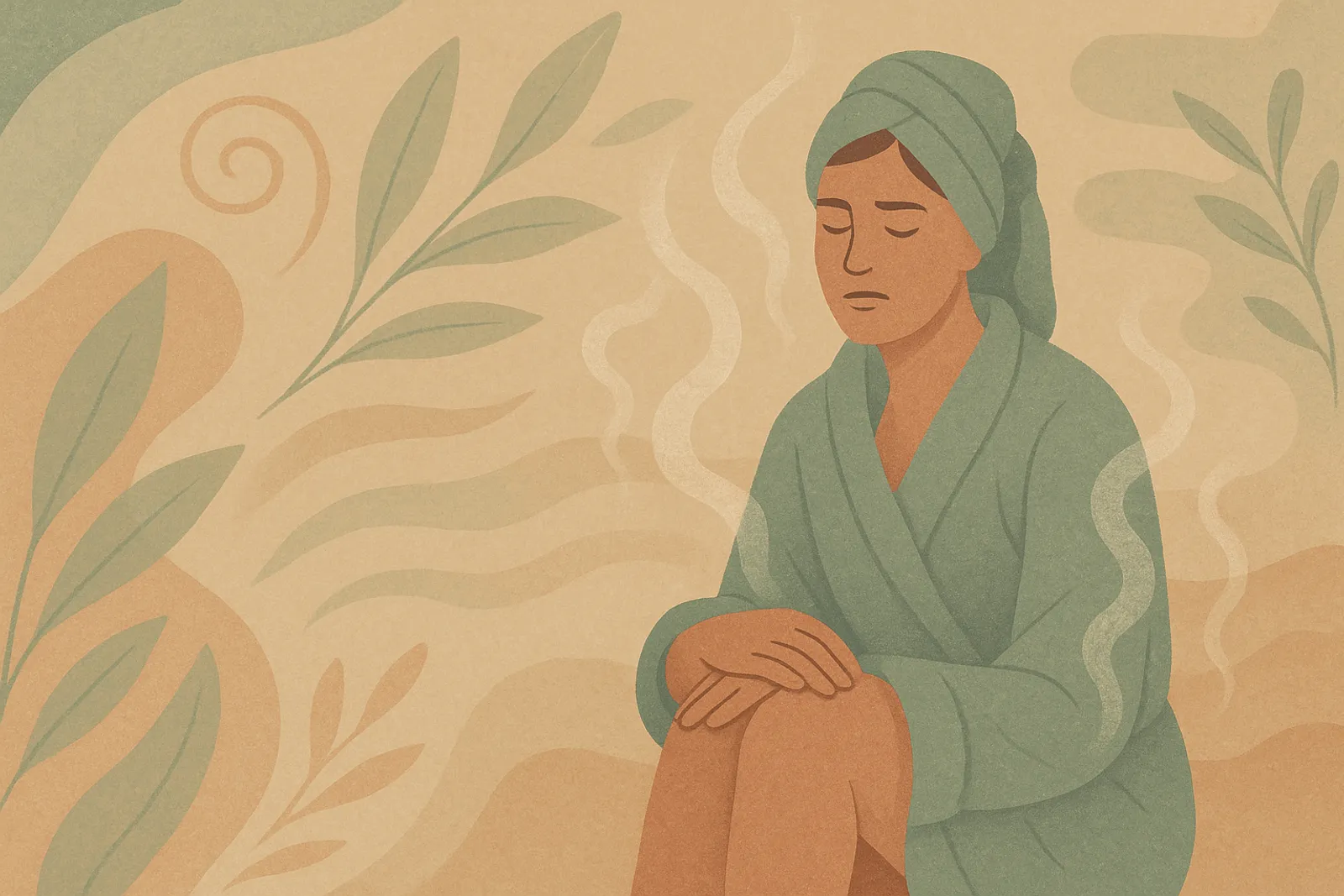The Hot Shower Thing — Why Does the Hot Water Help?
A comprehensive guide to understanding why hot showers provide relief for CHS (Cannabinoid Hyperemesis Syndrome) sufferers, backed by medical research and patient experiences.

6 min read
If you’ve ever found yourself standing under a scorching hot shower at 3am because it was the only thing keeping you from vomiting again… you’re not alone.
In fact, this very behavior has become one of the most distinctive hallmarks of Cannabinoid Hyperemesis Syndrome (CHS). For many people, it’s the first strange clue that something deeper is going on — and for a lot of us, it was one of the first things we typed into Google that eventually led to understanding what CHS even is.
But why hot showers? What’s really happening in your body to make this work when nothing else does?
Let’s talk about it.
What Is CHS Again?
Cannabinoid Hyperemesis Syndrome (CHS) is a condition that can develop in some long-term, frequent cannabis users. It causes waves of severe nausea, vomiting, and abdominal pain — often so intense it leads to ER visits. It’s often misdiagnosed as the flu, GERD, anxiety, or a dozen other things.
CHS is frustrating, scary, and still not widely understood — which is why many people suffering from it end up relying on online communities to find answers.
And one thing that nearly everyone in those communities reports?
Hot. Showers. Help.
The Hot Shower Effect — Real, or Placebo?
Let’s get this out of the way: it’s real.
While research on CHS is still developing, the hot shower phenomenon has been consistently documented in clinical studies and medical literature. It’s so common that some researchers even list “hot bathing behavior” as one of the key diagnostic signs of CHS.
But what’s behind it?
The Science: What We Think Is Happening
There are a few leading theories about why hot showers provide temporary relief during CHS episodes. While no single answer has been 100% confirmed, here’s what we currently know from the research:
1. Thermoregulation & TRPV1 Receptors
Cannabinoids (especially THC) affect a part of your nervous system that helps regulate body temperature, pain, and nausea through what are called TRPV1 receptors (Transient Receptor Potential Vanilloid 1).
These receptors are also activated by heat — and especially by capsaicin, the spicy compound in chili peppers. That’s why topical capsaicin cream (yes, the hot pepper stuff) is sometimes used in emergency rooms for CHS treatment.
The theory is this:
- THC may desensitize or dysregulate TRPV1 receptors over time.
- Hot water stimulates those receptors strongly.
- That stimulation may temporarily “reboot” the nausea signal or override the brain-gut pathway causing vomiting.
In short? The heat flips a switch. Temporarily.
2. Redistribution of Blood Flow
When you expose your skin to hot water, your body starts shunting blood away from your core (like your stomach) and toward the surface to help regulate temperature. That shift in circulation might ease gastrointestinal pain or reduce the intensity of nausea.
3. Distraction and Nerve Fatigue
Extreme heat on the skin creates a powerful sensory input — one that might temporarily drown out the brain’s nausea signals. You’re overloading your nervous system in a way that says, “Hey, pay attention to this burning heat instead of your stomach.”
It’s a little like how you might rub your elbow after bumping it — that physical sensation competes with the pain signal.
And for many of us, that works just well enough to buy some relief.
Community Wisdom: What People Say
If you spend even 5 minutes in a CHS-focused online community, you’ll see people mention hot showers as their go-to coping mechanism. Here are a few patterns people report:
- Relief can start within minutes of stepping into a hot shower or bath.
- Some people need very hot water — almost uncomfortably so.
- The relief usually fades once you step out.
- Many end up taking multiple hot showers a day during flare-ups.
- A few find relief using heating pads, saunas, or even just sitting in a steamy bathroom.
It doesn’t work for everyone — but for those it helps, it can be the only thing that makes symptoms bearable.
But Is It Safe?
Yes… with caution.
Hot showers might feel like the only relief during a CHS episode, but overuse can lead to dehydration, dry skin, or even burns if the water is too hot.
And because CHS already tends to cause dehydration (from vomiting and lack of appetite), it’s super important to replenish fluids and limit shower length when you can.
Some tips:
- Keep showers under 20 minutes.
- Stay hydrated before and after.
- Don’t crank the heat so high you burn your skin.
- Consider alternating with a heating pad or warm compress if you’re showering frequently.
So… Is This a Cure?
No. It’s a coping mechanism, not a cure.
Hot water can take the edge off CHS symptoms, but it doesn’t fix the root issue. Most research shows that the only long-term relief comes from adjusting cannabis use — whether that means stopping entirely or finding a new relationship with it.
That said, we’re not here to tell you to quit.
Everyone’s journey is different. We know people smoke for different reasons — pain, stress, trauma, sleep, and more. We’re not here to shame you for that.
We just want you to have the info.
So if you’re spending hours in the shower… it might be time to look a little deeper.
And know that you’re not alone.
Additional Resources
🧾 References
Academic Publications
Sorensen CJ, DeSanto K, Borgelt L, Phillips KT, Monte AA.
Cannabinoid Hyperemesis Syndrome: Diagnosis, Pathophysiology, and Treatment – A Systematic Review.
Journal of Medical Toxicology. 2017;13(1):71-87.
https://doi.org/10.1007/s13181-016-0595-zHabboushe J, Rubin A, Liu H, Hoffman RS.
The Prevalence of Cannabinoid Hyperemesis Syndrome Among Regular Marijuana Smokers in an Urban Public Hospital.
Basic & Clinical Pharmacology & Toxicology. 2018;122(6):660-662.
https://doi.org/10.1111/bcpt.12962Galli JA, Sawaya RA, Friedenberg FK.
Cannabinoid Hyperemesis Syndrome.
Current Drug Abuse Reviews. 2011;4(4):241-249.
https://pubmed.ncbi.nlm.nih.gov/21993885Simonetto DA, Oxentenko AS, Herman ML, Szostek JH.
Cannabinoid Hyperemesis: A Case Series of 98 Patients.
Mayo Clinic Proceedings. 2012;87(2):114–119.
https://doi.org/10.1016/j.mayocp.2011.10.005
Clinical Resources
Cleveland Clinic
Cannabinoid Hyperemesis Syndrome (CHS): Symptoms, Causes, Treatment.
https://my.clevelandclinic.org/health/diseases/22185-cannabinoid-hyperemesis-syndromeEmergency Medicine Cases Podcast – EP147
Cannabinoid Hyperemesis Syndrome
Includes discussion of TRPV1 activation and capsaicin treatment.
https://emergencymedicinecases.com/cannabinoid-hyperemesis-syndrome/
Community Resources
- Reddit Community: r/CHSinfo
Personal accounts, symptom tracking, hot shower strategies.
https://www.reddit.com/r/CHSinfo/
CHS Awareness
Awareness, Not Abstinence.
Did you find this article helpful? Help us keep creating free CHS resources.
❤️ Support CHS Awareness
